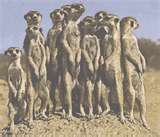Meekat

The meerkat or suricate Suricata suricatta is a small mammal and a member of the mongoose family.
Grouping

A meerkat group may die out because of predator attack, its alpha pair being unable to breed, starvation in a year when the rains fail, or epidemic disease.
A new meerkat group often arises from evicted females meeting and staying with roving males, looking for chances to mate. The litter size is usually 2-5 pups.
The size of the groups is variable. A group which becomes over-large may routinely have to disperse widely to find enough food when foraging. As a result, when suddenly needing to run for shelter, members of the group may choose different holes, resulting in the group fissioning.
Size
Head to tial is about 20 in., and can wiegh up to 2 pounds
Feeding
Meerkats are primarily insectivores, but also eat lizards, snakes, scorpions, spiders, plants, eggs, small mammals, millipedes, centipedes and, more rarely, small birds. They are partially immune to certain venoms; they are immune to the very strong venom of the scorpions of the Kalahari, unlike humans.They have no excess body fat stores, so foraging for food is a daily need.
Meerkats forage in a group with one "sentry" on guard watching for predators while the others search for food. Sentry duty is usually approximately an hour long. Baby meerkats do not start foraging for food until they are about 1 month old, and do so by following an older member of the group who acts as the pup's tutor. The meerkat standing guard makes peeping sounds when all is well. If the meerkat spots danger, it barks loudly or whistles.
Breeding

Meerkats become sexually mature at about one year of age and can have 1 to 5 pups in a litter, with 3 pups being the most common litter size. Wild meerkats may have up to four litters per year. Meerkats are iteroparous and can reproduce any time of the year but most births occur in the warmer seasons. The female meerkat can have more than one litter a year. The pups are allowed to leave the burrow at three weeks old. When the pups are ready to emerge from the burrow, the whole clan of meerkats will stand around the burrow to watch. Some of the adolescents might try to show off so they can have more attention than the pups.
Behavior
Meerkats are small burrowing animals, living in large underground networks with multiple entrances which they leave only during the day. They are very social, living in colonies averaging 20-30 members. Animals in the same group regularly groom each other to strengthen social bonds. The alpha pair often scent-mark subordinates of the group to express their authority, and this is usually followed by the subordinates grooming the alphas and licking their faces. This behavior is also usually practiced when group members are reunited after a short period apart. Most meerkats in a group are all siblings or offspring of the alpha pair.
Meerkats demonstrate altruistic behavior within their colonies; one or more meerkats stand sentry (lookout) while others are foraging or playing, to warn them of approaching dangers. When a predator is spotted, the meerkat performing as sentry gives a warning bark, and other members of the gang will run and hide in one of the many bolt holes they have spread across their territory. The sentry meerkat is the first to reappear from the burrow and search for predators, constantly barking to keep the others underground. If there is no threat, the sentry meerkat stops signalling and the others feel safe to emerge.
Meerkats also babysit the young in the group. Females that have never produced offspring of their own often lactate to feed the alpha pair's young, while the alpha female is away with the rest of the group. They also protect the young from threats, often endangering their own lives. On warning of danger, the babysitter takes the young underground to safety and is prepared to defend them if the danger follows. If retreating underground is not possible, she collects all young together and lies on top of them.
